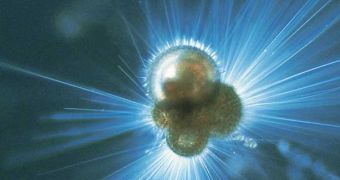The Foraminifera ("Hole Bearers") represent a group of amoeba-related protozoa that produce a test (shell) which can have either one or multiple chambers, and in some cases can be extremely complex. The shells are perforated by holes through which the unicellular animal extends its "tentacles", called "pseudopodia", which are employed for both attaching and feeding, like in the case of Amoeba. In fact, Foraminifera can catch and ingest creatures many times bigger than their own mass.
They live on the underside of the reefs, on the sea floors, beneath rocks and in caves, being part of the plankton. Some are bioluminescent. These protozoans are among the most abundant unicellular organisms in the ocean, being a crucial part in the feeding chain (bivalves and other mollusks consume large amounts of Foraminifera). Foraminifera are essential in recycling elements in the oceans: they build carbonate shells and, due to their sheer numbers, they work like a "carbon sink", absorbing carbon and calcium from the water.
275,000 fossil and living species are known; most of them have less than 1 mm, but the largest foraminifera are also the largest protozoa: 19 cm (7.6 in) and they represent just one cell.
1. Fossil foraminifera are used for precise dating of geological samples. Depending on this, the geologists can take the decision to continue or stop the drilling work when looking for oil, for example.
Analysis of the foraminifera shells can be connected to specific water and atmospheric temperatures, and can reveal patterns of sea level fluctuations, based on sediment analysis. The foraminifera fossils can also be radiocarbon-dated.
2. You know that sand comes in colors of yellow, white, or gray. Sometimes, if it's volcanic, also black. But what about a pink sand beach? Foraminifera caused such a rare phenomenon in Harbour Island (Bahamas). The pale pink sand beaches, some over 3 miles (5 km) long and 50 to 100 feet (15 to 30 m) wide, are some of the very best beaches in the archipelago. The beach is located 50 mi (80 km) east of Nassau (the capital of the Bahamas) and it is sheltered by a coral reef.
The unusual sand is a mix of bits of coral, broken mollusk shells, minute rocks and pink or red shells of Foraminifera, made of calcium carbonate. When Foraminifera die, they are washed up on shore due to the action of the waves, but the shells can reach the shore also as the fish knock them loose when they feed on the fleshy part of the animals.
3. When a team analyzed, in 2007, the DNA of deep-sea foraminifera, encountered at the North and South Poles, they found they belong to the same species. Even more surprising was the discovery of a much stronger gene flow in foraminifera from the Antarctic to the Arctic, but not vice versa. This was linked to the deep Antarctic water flow towards the north, delivering the deep water masses in the other oceans.
4. The research of the glue produced by Foraminifera when building their shells could lead to the synthesis of stronger biological adhesives, extremely necessary in fields like dentistry, neurological surgery and the development of artificial arms and limbs. It appeared that the Foraminifera adhesive material is more complex than thought, the basis being represented by a protein mix, heavily coated with sticky carbohydrates.

 14 DAY TRIAL //
14 DAY TRIAL //